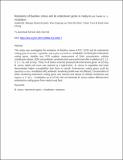| dc.description.abstract | This study was investigated the resistance of Bacillus cereus ATCC 13752 and its enterotoxin coding genes in cereals, vegetables, and tryptic soy broth to γ-irradiation. Screening for enterotoxin coding genes, viability test, PCR analysis, measurement of DNA concentration, cellular constituents release, SEM, and antibiotic sensitivity tests were performed after irradiation at 0, 1.5, 3, 5, 7, 10, and 15 kGy. Thirty % of strains screened possessed all enterotoxins genes. At 10 kGy B. cereus viable cell count was reduced by 4 logCFU/mL. B. cereus in vegetables and broth demonstrated higher susceptibility than those in cereals. Enterotoxins coding genes could be identified in the γ-irradiated cells, antibiotic sensitivity profile was not affected. Concentration of DNA containing enterotoxin coding genes was reduced and release of cellular constituent was highest at 15 kGy. γ-Irradiation up to 10 kGy did not eliminate B. cereus neither affected their enterotoxins coding genes from ready-to-eat food. | en_US |

